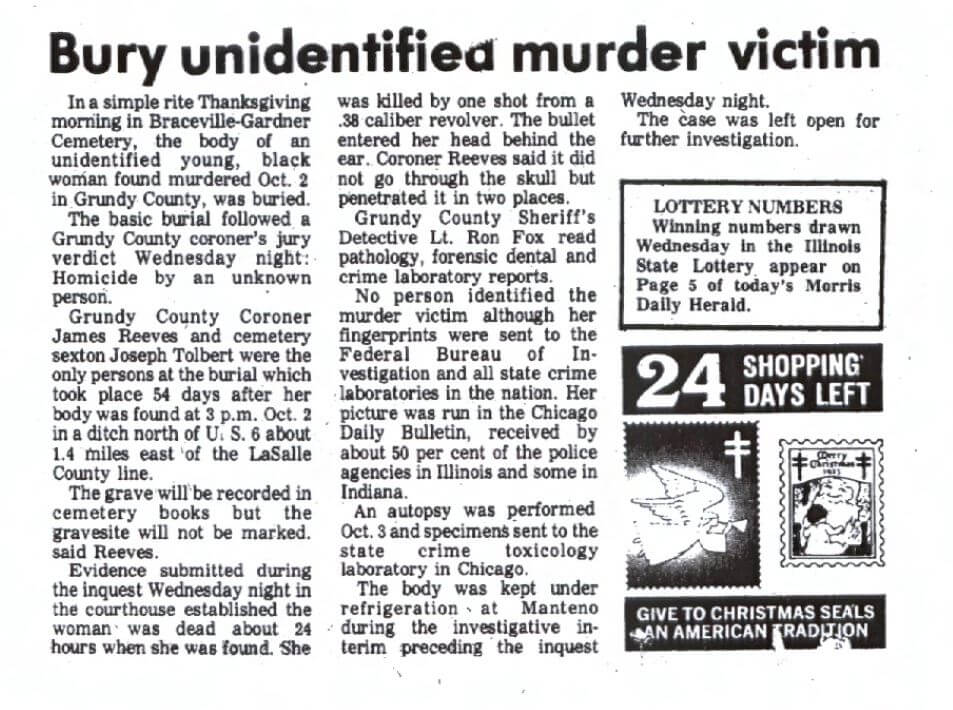***UPDATE***
On June 27, 2024, the Grundy County Coroner’s Office announced that Jane “Seneca” Doe had been identified as JoAnn “Vicky” Smith. Vicky lived in Lincoln Heights, a suburb of Cincinnati, with her family when she disappeared from her home in 1976. She was only 20 years old.
Vicky’s body was found in a ditch at a farm in Grundy County, about 90 minutes outside of Chicago, with a garbage bag and her sweater wrapped around her head. She died from a gunshot wound. After being buried in an unmarked grave on Thanksgiving Day, 1976, she remained unidentified for almost 48 years.
During the press conference (watch in Video Section below), Brandon Johnson, Deputy Chief at Grundy County Coroner’s Office, described the complex genealogy investigation that included Vicky being adopted.
When asked if this was one of his proudest moments, Brandon Johnson responded, “Most rewarding.”
The homicide investigation remains unresolved, but with Vicky now identified, investigators can work to find who killed her.
***ORIGINAL SPOTLIGHT***
August 12, 2019 | By Kadi Thomas
This story is part of a collaborative project between Project: Cold Case and a University of North Florida Journalism class. The student credited above wrote this story as a class project.
Miss Jane Seneca Doe was murdered 43 years ago. She was an African American female, between 15 and 27 years old, who stood approximately 5 feet, 7 inches tall, and weighed around 150 pounds, with black hair and brown eyes.
She was found on the side of the road along U.S. Route 6 in unincorporated Seneca, Grundy County, Illinois, about one day post-mortem on October 2, 1976. Her death was the result of a gunshot wound to the head.
She was buried as an unnamed person on the Thanksgiving following her murder. But thanks to a dedicated coroner, she is not forgotten all these years later.
After more than four decades, investigators still don’t know her birth name or the name of her killer. But in recent years, Deputy Coroner Brandon Johnson has come closer than ever to solving the mystery.
The case has been able to progress further than before thanks to advancements of DNA analytic technologies, and the determination of Johnson. When Doe was recovered, there were very few clues available to help identify her or her killer. The deputies who work the case have their uncertainties but are confident that she was not a resident of Grundy County.
During the 1970 census, the county population was only 1,781. In a small town of almost all white residents, the citizens would know the name of an African American woman in the township. Still to this day, Seneca maintains its quiet, quaint personality. Doe is still the small town’s only cold case in recorded history.
She was found with a red, white, and black sweater wrapped around her head, soaked in the blood of multiple people. This makes it difficult to pinpoint whether the blood belongs to her or her assailant. It is thought that the blood may be a mix that includes her DNA, and possibly the DNA of another victim. Unlike in 1976, forensic testing is much better today. The advances are due in large part to the copious amounts of logged DNA and to the popularity of individuals using genealogy companies to learn about their own ancestry.
Doe was exhumed from her grave on December 17, 2018. Since then, her existing forensic evidence has been sent to the University of North Texas. As of late April, North Texas has developed DNA of a female profile and entered it into the CODIS system used by the FBI. It is currently being compared to other missing persons samples on file nationwide.
Jane Seneca Doe’s face and story have been shared in a number of ways, including on the Grundy County Coroner’s website, The National Center for Missing and Exploited Children, The Doe Network, NamUs and The Vanished podcast. In June, Johnson enlisted the assistance of the DNA Doe Project, which focuses on genealogical DNA testing – another avenue to help search for any family.
Johnson is confident that he will soon be able to give Doe the name that she deserves and bring answers to a family who has wondered where she went for more than 40 years. New upgrades in forensic science have given Johnson a reaffirmed faith that he will see her be identified. He says that until recently he has, “never seen so many unidentified cases come to light.”
Anyone who has any information about this case and the identity of the victim, or information of the suspect(s) is encouraged to contact the Grundy County Coroner’s Office at (815) 942-3792.
Please consider using the buttons below to share this case in hopes that someone, somewhere will come forward and give this victim and family the answers they need and justice they deserve.
If you have a loved one that is the victim of an unsolved homicide, please submit their case here for consideration in a future Cold Case Spotlight post.

















